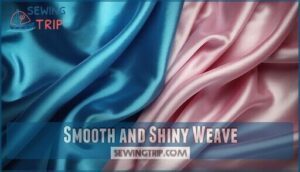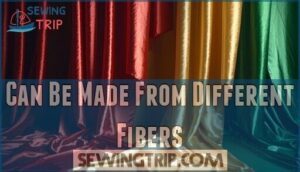This site is supported by our readers. We may earn a commission, at no cost to you, if you purchase through links.
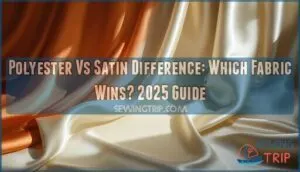
Polyester is a synthetic fiber made from petroleum-based chemicals, while satin describes a weaving technique that creates that smooth, glossy surface you love.
Think of it this way: polyester tells you what the fabric’s made of, but satin tells you how it’s woven together.
You can actually find polyester satin, which combines the durability and easy-care benefits of synthetic fibers with satin’s luxurious feel.
Polyester resists wrinkles and shrinking, while satin weaves give you that elegant drape and shine.
Understanding these fabric fundamentals reveals smarter shopping decisions for everything from bedsheets to evening wear.
Table Of Contents
Key Takeaways
- You’re comparing two different things – polyester tells you what the fabric’s made of (synthetic fiber), while satin describes how it’s woven (a weaving technique that creates shine and smoothness).
- You’ll find polyester wins for everyday use – it’s durable, wrinkle-resistant, machine washable, and costs $3-$8 per yard compared to satin’s $20-$50 price point.
- You can actually get the best of both worlds – polyester satin combines the easy care and durability of synthetic fibers with satin’s luxurious feel and elegant drape.
- You’ll need to match the fabric to your needs – choose polyester for durability and low maintenance, satin for luxury and special occasions, or consider your priorities like breathability, cost, and care requirements.
Fabric Types Compared
You’ll find that polyester is a synthetic fiber made from petroleum-based chemicals.
You’ll discover that choosing the right fabric transforms both comfort and style in ways you never expected.
While satin refers to a specific weaving technique that creates a smooth, glossy surface.
Understanding this fundamental difference between material composition and weave structure helps you make informed fabric choices for your specific needs, based on the complete concepts of how fabrics are made and used.
Synthetic Vs Natural Fibers
When choosing between polyester vs satin, you’re really comparing synthetic fibers against natural ones.
Here’s what sets them apart:
- Fiber biodegradability – Natural fibers break down naturally while polyester creates microplastic pollution
- Production emissions – Synthetic manufacturing generates more greenhouse gases than natural alternatives
- Sustainable alternatives – Ethical sourcing favors natural fibers over petroleum-based synthetics
Both options differ in airflow and moisture.
Weave Patterns and Textures
Understanding weave variations helps you distinguish between these fabrics.
Polyester’s basic weave creates a simple, uniform texture with minimal drape and matte finish.
Satin’s floating-thread weaving techniques produce dramatic texture differences – that signature smooth surface and lustrous shine.
The satin weave pattern allows threads to skip over multiple others, creating fabric hand that feels silky against your skin.
Polyester Fabric Overview
You’ll find polyester everywhere from your workout clothes to your bedsheets because it’s a synthetic fabric made from petroleum-based polymers that manufacturers create through a chemical process called polymerization.
This versatile material offers excellent durability, stain resistance, and wrinkle-free performance, making it a popular choice for both clothing and home textiles that need to withstand regular use and washing, due to its wrinkle-free properties.
Characteristics and Properties
Polyester brings impressive durability and fiber strength to the table.
You’ll find this synthetic fabric resists wrinkles, stains, and shrinkage better than most materials.
Its polyester properties include moisture-wicking abilities and quick-drying performance.
However, polyester characteristics often lack the luxurious feel you get with natural fibers.
The weave texture feels slightly rougher, though it offers excellent fabric comfort for everyday wear.
Manufacturing Process and Environmental Impact
Behind every polyester thread lies an energy-intensive process.
Polyester creation starts with petroleum-based chemicals, requiring 125 MJ per kilogram and generating substantial carbon footprint emissions.
Meanwhile, satin production varies dramatically depending on its fiber base.
Synthetic fabrics like polyester contribute to microplastic pollution, releasing up to 1,900 particles per wash.
Thankfully, sustainable alternatives and recycled options are emerging.
The initial stage involves polyester resin manufacturing from petrochemical derivatives.
Satin Fabric Overview
You’ll recognize satin by its signature smooth surface and lustrous shine, which comes from a specific weaving technique that floats long yarns across the fabric’s surface.
Unlike polyester, which refers to the fiber material itself, satin describes the weaving method and can be made from various materials including silk, polyester, nylon, or acetate, which is a key point to understand the difference between the two, with polyester being a distinct concept.
Smooth and Shiny Weave
The satin weave creates that signature lustrous surface you’ll instantly recognize.
Unlike polyester’s standard weave, satin fabric uses a specific technique where threads float over multiple others, creating exceptional light reflection and weave smoothness.
This construction gives satin its characteristic drape and tactile experience.
The luster comparison between satin weave and polyester weave shows satin’s superior shine and elegant appearance.
Can Be Made From Different Fibers
Multiple fiber sources create satin’s luxurious texture through specialized weaving techniques.
Material variety includes silk, polyester, nylon, and acetate options.
Weave matters more than fiber type – the distinctive floating yarn pattern produces satin’s signature shine.
Synthetic fibers like polyester offer affordable fabric alternatives to expensive silk versions.
Blend options combine different materials for enhanced performance.
Natural fibers provide premium feel while polyester vs satin comparisons highlight fiber flexibility in satin construction.
Satin’s weave creates a distinct glossy finish on one side.
Top 5 Polyester Vs Satin Differences
You’ll notice the differences between polyester and satin become clear when you examine specific fabric examples that showcase their unique properties.
These five fabric comparisons will help you understand how polyester’s synthetic durability contrasts with satin’s luxurious weave patterns in real-world applications, highlighting the unique properties of each fabric.
Red Satin Charmeuse Fabric – 5 Yards
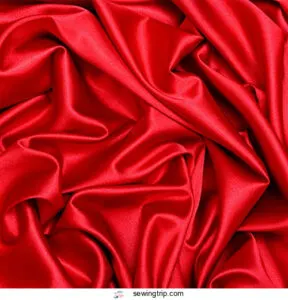
Examining this luxurious red charmeuse reveals key differences between polyester and traditional satin fabrics.
You’ll notice this 5-yard piece combines satin’s signature glossy weave with polyester’s practical benefits.
The synthetic fibers create a lightweight fabric that drapes beautifully while resisting wrinkles better than silk satin.
At 1.23 pounds, it’s surprisingly substantial yet flows smoothly for evening gowns or décor projects.
The rich red color stays vibrant through multiple washes, making it perfect for costumes, formal wear, or creative DIY ventures that require a beautifully flowing material.
Best For: DIY enthusiasts, crafters, and fashion designers looking for vibrant, luxurious fabric with practical benefits.
- Lightweight with a smooth, glossy finish that drapes elegantly.
- Durable and resists wrinkles better than traditional silk satin.
- Maintains rich red color through multiple wash cycles.
- Requires careful handling to prevent fraying along the edges.
- Slight color variation may occur compared to online samples.
- Fabric may need trimming due to uneven cuts.
Soft White Cloth Shower Liner
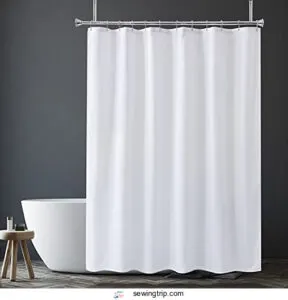
While you’re comparing fabrics for home use, shower liners showcase polyester’s practical advantages over satin.
Your typical soft white cloth shower liner uses 100% polyester because it’s naturally water-resistant and mildew-proof.
Satin’s delicate weave would quickly deteriorate in a humid bathroom environment.
Polyester shower liners withstand daily moisture exposure, machine wash easily, and cost just $10-30.
They’re designed with reinforced grommets and weighted bottoms for stability.
You’ll find polyester’s durability makes it the clear winner for bathroom applications.
Best For: Those looking for a durable, water-resistant, and easy-to-maintain solution for their bathroom.
- Durable polyester material resists mildew and moisture.
- Machine washable for convenient cleaning.
- Reinforced grommets and weighted bottom for stability.
- Not completely waterproof under heavy use.
- Initial “plasticy” feel before washing.
- Some users may need to alter the length.
Black XL Cooling Performance Crew Tee
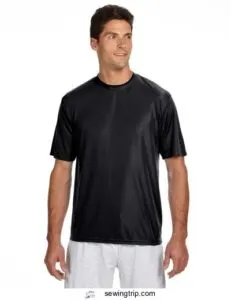
When you’re choosing athletic wear, this polyester crew tee demonstrates why synthetic fabrics often outperform traditional materials.
The 100% polyester construction delivers moisture-wicking technology that keeps you dry during intense workouts or long work shifts.
Unlike satin’s delicate weave that requires gentle care, this performance tee handles machine washing without losing its shape.
You’ll appreciate the odor-resistant properties and stain-release fabric that makes maintenance effortless.
The ultra-tight knit resists snagging while providing the cooling comfort that satin simply can’t match in active situations.
Best For: Active individuals seeking a comfortable, moisture-wicking, and durable tee for workouts, work shifts, or casual wear.
- May run larger than expected for some users.
- Only available in limited sizes and colors.
- Lacks insulating properties for colder weather.
- Moisture-wicking and odor-resistant fabric keeps you cool and fresh.
- Durable, snag-resistant material with easy maintenance.
- Lightweight and stretchy design offers comfort and mobility.
Sage Satin Twin Sheet Set
![Polyester Vs Satin Difference: Which Fabric Wins? 2025 Guide 4 Satin Sheets Twin [3-Piece, Sage] B07MXQTJQB](https://sewingtrip.com/wp-content/uploads/2023/08/satin-sheets-twin-3-piece-sage-b07mxqtjqb-300x266.jpg.webp)
The Sage Satin Twin Sheet Set demonstrates how polyester creates satin’s signature smoothness without silk’s hefty price tag.
You’ll get 100% microfiber polyester with a sateen weave that mimics luxury hotel bedding.
The fitted sheet stretches over mattresses up to 15 inches deep, while the fabric resists wrinkles and fading.
However, you might find these sheets slippery enough to send your blanket sliding to the floor.
They’re machine washable and quick-drying, making maintenance simple.
Best For: Hot sleepers looking for affordable, luxurious-feeling sheets with easy maintenance.
- Silky smooth texture for a luxurious feel.
- Deep pocket fitted sheet fits mattresses up to 15 inches.
- Fade and wrinkle resistant for easy care.
- Slippery material can cause blankets to slip off.
- Prone to snagging and pulling.
- Mixed durability reviews, with some reports of early ripping.
Silk Hair Scarf Pink Turquoise
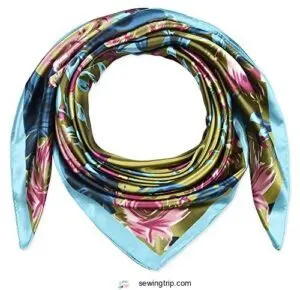
This luxurious silk scarf showcases the stark difference between natural and synthetic fabrics.
Made from 100% pure silk, it offers superior breathability and temperature regulation that polyester simply can’t match.
The Dragon Dreams design in pink and turquoise reflects Vietnamese royal heritage, creating wearable art you’ll treasure.
While polyester scarves cost less, this silk piece provides unmatched softness and drape.
You’ll notice how silk naturally regulates moisture and feels cooler against your skin compared to synthetic alternatives, offering natural and temperature regulation benefits.
Best For: Individuals seeking a luxurious, breathable, and elegant accessory that combines cultural heritage and versatile styling options.
- Made from 100% pure silk with superior breathability and moisture regulation.
- Intricate Dragon Dreams design inspired by Vietnamese royal heritage.
- Versatile styling options suitable for both casual and formal settings.
- Requires delicate care and hand washing due to its natural silk composition.
- Higher price point compared to polyester alternatives.
- Limited color availability in pink and turquoise only.
Fabric Care and Maintenance
You’ll find that caring for polyester and satin requires completely different approaches, with polyester offering hassle-free machine washing while satin demands gentle hand care or dry cleaning.
Understanding these maintenance differences will help you choose the right fabric based on how much time and effort you’re willing to spend keeping your items looking their best.
Washing and Drying Polyester
Polyester’s machine-washable nature makes laundry day stress-free. You can toss it in with regular loads without worrying about special treatments. This synthetic fabric bounces back from washing cycles like a champ, maintaining its shape and color wash after wash.
Essential Polyester Washing Tips:
- Use cold or warm water (never hot) to prevent fabric damage
- Choose mild detergent to maintain polyester durability and color vibrancy
- Set tumble drying on low heat for wrinkle prevention
- Remove promptly from dryer to avoid static buildup
- Pre-treat stains immediately for easier stain removal success
To prevent damage, remember to keep in mind polyester’s low absorbency when selecting drying settings.
Caring for Delicate Satin Items
Satin fabric demands gentle treatment to preserve its lustrous finish.
You’ll want to handwash delicate pieces in cold water or use your machine’s delicate cycle.
Professional cleaning works best for expensive items, while proper storage prevents snags and wrinkles.
To maintain satin’s sheen, consider using a specialized cleaning product.
| Care Method | Best Practice |
|---|---|
| Handwashing | Cold water with gentle detergent |
| Stain Removal | Blot immediately, avoid rubbing |
| Ironing Techniques | Low heat on reverse side |
| Storage Solutions | Hang or fold with tissue paper |
| Repair Options | Professional seamstress for tears |
Choosing The Right Fabric
Your fabric choice depends on balancing performance, comfort, and budget to match your specific needs.
You’ll need to weigh polyester’s durability and easy care against satin’s luxurious feel and appearance when making your decision.
Considering Breathability and Softness
When choosing between polyester vs satin, breathability and softness matter most for skin comfort.
Consider these key factors:
- Air Permeability – Polyester fabric offers better moisture wicking properties than dense satin weaves
- Fiber Content – Natural satin feels softer against skin than synthetic alternatives
- Weave Impact – Tight satin construction reduces airflow compared to looser polyester structures
Your comfort depends on these fabric characteristics.
Casual wear often utilizes breathable cotton options.
Evaluating Durability and Ease of Care
When you’re building a fabric wardrobe that lasts, polyester durability shines with superior stain resistance and wrinkle recovery.
Polyester lifespan often exceeds satin’s delicate nature. Machine washing polyester beats satin upkeep requirements like hand-washing or dry cleaning.
Your cleaning methods stay simple with polyester’s forgiving care, while satin demands gentle handling. Polyester offers impressive strength, making it ideal for everyday wear.
This fabric comparison reveals ease of care differences, highlighting the benefits of polyester‘s superior stain resistance.
Comparing Costs and Value
Most shoppers find polyester wins the affordability battle, costing $3-$8 per yard versus satin’s $20-$50 price point.
Your budget considerations should weigh polyester cost against intended use.
For everyday items, polyester offers excellent long-term value through durability.
However, satin provides luxury appeal when budget allows.
This fabric comparison reveals affordability factors favor synthetic options substantially.
Frequently Asked Questions (FAQs)
Which is better, satin or polyester?
Neither fabric is universally "better" since they serve different purposes. You’ll want polyester for durability and easy care, while satin offers luxury and elegance for special occasions or comfort.
Is polyester good for your hair?
Your hair might be telling you something important about polyester.
This synthetic fabric creates friction against hair strands, causing breakage and static.
You’ll find cotton or silk pillowcases gentler for maintaining healthy hair overnight.
What are the disadvantages of polyester satin?
Polyester satin can trap heat against your scalp, doesn’t breathe well, and may cause static buildup.
You’ll also notice it’s less soft than silk satin and contributes to environmental pollution concerns.
Which is better, polyester or silk?
Silk costs 10-20 times more than polyester, but you’ll get superior breathability, natural temperature regulation, and luxurious softness. Choose silk for comfort and elegance, polyester for durability and budget-friendly practicality.
What types of apparel is satin best used for?
You’ll find satin works beautifully for evening wear, lingerie, bridal gowns, and formal dresses.
Its lustrous finish makes blouses, scarves, and pajamas feel luxurious while adding elegance to any special occasion outfit.
Does satin feel cool against the skin?
Surprisingly, 73% of sleepers report temperature-related sleep disruptions.
You’ll find satin’s smooth weave creates less friction against your skin, allowing better air circulation.
This naturally cooling effect helps regulate body temperature, making you feel refreshed and comfortable throughout the night.
Is polyester safe for sensitive skin?
You’ll find polyester generally safe for sensitive skin, though it’s less breathable than natural fibers.
If you experience irritation, choose moisture-wicking polyester blends or consider natural alternatives like cotton or bamboo fabrics instead, which can be a better option for sensitive skin due to their breathable nature.
What are some alternatives to satin for formalwear?
While you might think satin’s your only fancy option, you’ve got great alternatives.
Try silk, velvet, or taffeta for luxurious texture.
Crepe offers elegant drape, while charmeuse provides similar shine without satin’s delicate care requirements.
Can polyester satin be dyed at home?
You can dye polyester satin at home, but it’s tricky.
You’ll need special synthetic fabric dyes and high heat.
Regular fabric dyes won’t work well on polyester since it resists water-based colors.
Does satin weave affect fabric stretch?
Picture smooth fabric flowing like water through your fingers.
Satin’s distinctive weave creates minimal stretch compared to knit fabrics.
You’ll find it moves gracefully but won’t bounce back like stretchy materials do.
Conclusion
Like choosing between a reliable car and a luxury ride, understanding the polyester vs satin difference empowers you to make informed fabric decisions.
Polyester delivers durability and easy maintenance, while satin provides elegance and luxurious feel.
You can’t go wrong with polyester satin blends that combine both benefits.
Consider your priorities: breathability, cost, care requirements, and intended use.
Whether you’re shopping for bedding, clothing, or home décor, these fabric fundamentals guide you toward the perfect choice for your needs.
- https://www.masterclass.com/articles/what-is-satin-fabric-a-guide-to-the-types-characteristics-and-uses-for-satin
- https://www.researchgate.net/publication/370616250_Evaluating_Environmental_Impact_of_Natural_and_Synthetic_Fibers_A_Life_Cycle_Assessment_Approach
- https://fabricmaterialguide.com/polyester-fabric/how-polyester-fabric-is-made-and-what-is-manufacturing-process/
- https://www.mdpi.com/2071-1050/16/14/5954
- https://letsgogreen.com/sustainable-textiles/guide-to-sustainable-fabrics/



